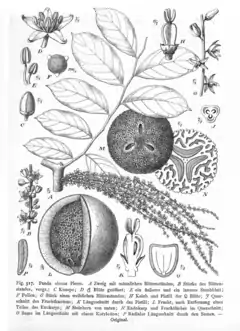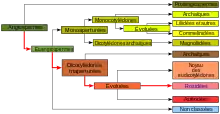Pandaceae
La famille des Pandacées regroupe des plantes dicotylédones ; elle comprend une trentaine d'espèces réparties en 3 à 5 genres.

| Règne | Plantae |
|---|---|
| Sous-règne | Tracheobionta |
| Division | Magnoliophyta |
| Classe | Magnoliopsida |
| Sous-classe | Rosidae |
| Ordre | Euphorbiales |

Ce sont des arbustes ou des arbres des régions tropicales, originaires de l'Afrique de l'Ouest et de l'Asie du Sud-Est.
Étymologie
Le nom vient du genre type Panda, nom vernaculaire au Nigeria et au Cameroun[1].
Classification
La classification phylogénétique APG II (2003)[2] et la classification phylogénétique APG III (2009)[3] situent cette famille dans l'ordre des Malpighiales.
Liste des genres
Selon World Checklist of Selected Plant Families (WCSP) (24 mai 2010)[4], Angiosperm Phylogeny Website (24 mai 2010)[5] et NCBI (24 mai 2010)[6] :
Selon DELTA Angio (24 mai 2010)[7] :
- Bhesa (en) : parfois classé dans les Centroplacaceae
- Centroplacus (en) : parfois classé dans les Centroplacaceae
- Galearia
- Microdesmis
- Panda
Liste des espèces
Selon World Checklist of Selected Plant Families (WCSP) (24 mai 2010)[4] :
- genre Galearia Zoll. & Moritzi (1846)
- Galearia aristifera Miq., Fl. Ned. Ind. (1861)
- Galearia celebica Koord., Meded. Lands Plantentuin 19: 584, 626 (1898)
- Galearia filiformis (Blume) Boerl. (1890)
- Galearia fulva (Tul.) Miq. (1859)
- Galearia maingayi Hook.f. (1887)
- Galearia stenophylla Merr. (1922)
- genre Microdesmis Planch. (1848)
- Microdesmis afrodecandra Floret, A.M.Louis & J.M.Reitsma, Bull. Mus. Natl. Hist. Nat., B (1989)
- Microdesmis camerunensis J.Léonard (1961)
- Microdesmis caseariifolia Planch. ex Hook. (1848)
- Microdesmis haumaniana J.Léonard (1961)
- Microdesmis kasaiensis J.Léonard (1961)
- Microdesmis keayana J.Léonard (1961)
- Microdesmis klainei J.Léonard (1961)
- Microdesmis magallanensis (Elmer) Steenis (1955)
- Microdesmis pierlotiana J.Léonard (1961)
- Microdesmis puberula Hook.f. ex Planch. (1848)
- Microdesmis yafungana J.Léonard (1961)
- genre Panda Pierre (1896)
- Panda oleosa Pierre (1896)
Notes et références
- Umberto Quattrocchi, CRC World Dictionary of Medicinal and Poisonous Plants : Eponyms, Synonyms, and Etymology, Boca Raton, CRC Press, , 4038 p., p. 2774
- (en) Angiosperm Phylogeny Group, « An update of the Angiosperm Phylogeny Group classification for the orders and families of flowering plants: APG II », Botanical Journal of the Linnean Society, Wiley-Blackwell, Linnean Society of London et OUP, vol. 141, no 4, , p. 399–436 (ISSN 0024-4074 et 1095-8339, DOI 10.1046/J.1095-8339.2003.T01-1-00158.X)
- (en) Angiosperm Phylogeny Group, « An update of the Angiosperm Phylogeny Group classification for the orders and families of flowering plants: APG III », Botanical Journal of the Linnean Society, Wiley-Blackwell, Linnean Society of London et OUP, vol. 161, no 2, , p. 105–121 (ISSN 0024-4074 et 1095-8339, DOI 10.1111/J.1095-8339.2009.00996.X)
- WCSP. World Checklist of Selected Plant Families. Facilitated by the Royal Botanic Gardens, Kew. Published on the Internet ; http://wcsp.science.kew.org/, consulté le 24 mai 2010
- Stevens, P. F. (2001 onwards). Angiosperm Phylogeny Website. Version 14, July 2017 [and more or less continuously updated since]." will do. http://www.mobot.org/MOBOT/research/APweb/, consulté le 24 mai 2010
- NCBI, consulté le 24 mai 2010
- DELTA Angio, consulté le 24 mai 2010
Liens externes
- (en) Référence Flora of China : Pandaceae
- (en) Référence Kew Garden World Checklist : Pandaceae
- (en) Référence Angiosperm Phylogeny Website : Pandaceae ()
- (en) Référence DELTA Angio : Pandaceae Pierre
- (en) Référence Paleobiology Database : Pandaceae Engler and Gilg
- (fr+en) Référence ITIS : Pandaceae Engl. & Gilg
- (en) Référence NCBI : Pandaceae (taxons inclus)
- (en) Référence GRIN : famille Pandaceae Engl. et Gilg (+liste des genres contenant des synonymes)